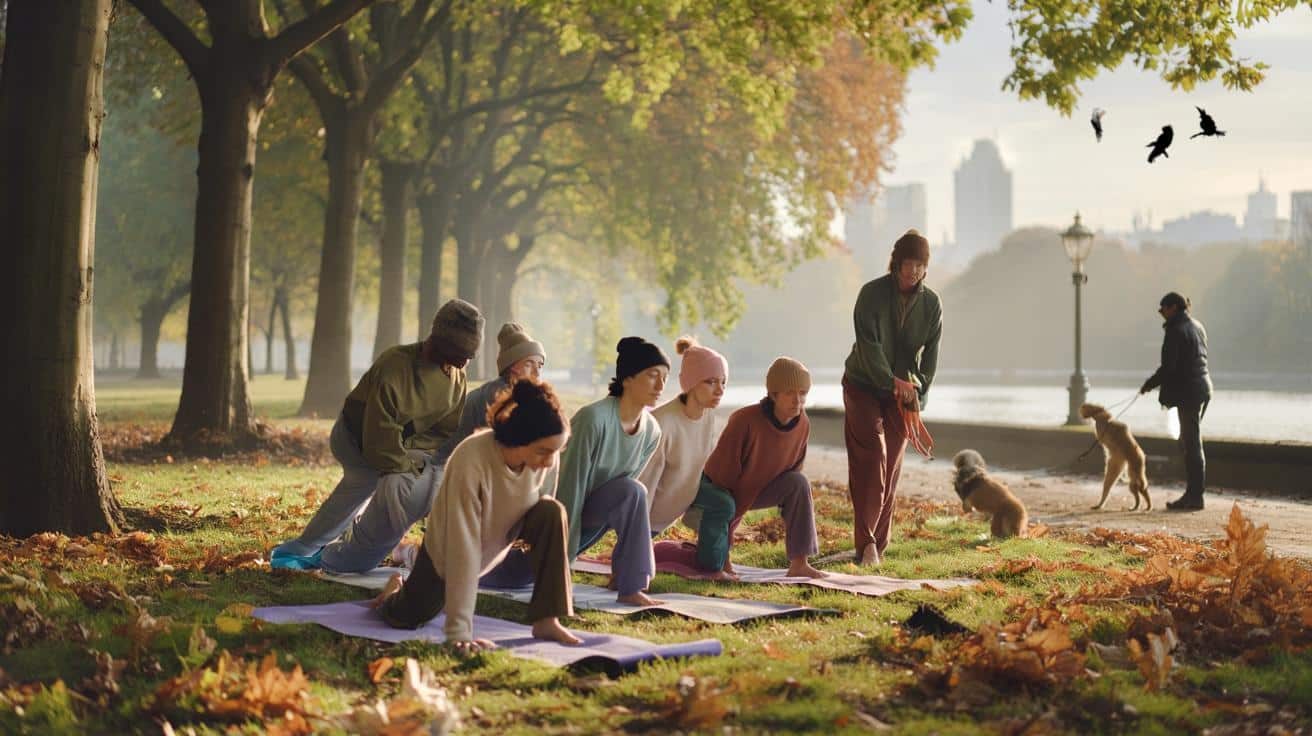Autumn 2025 is biting. Busier inboxes, darker evenings, nagging headlines. A fitness coach says the fix might be simpler than we think: take your mat to the park and breathe where the leaves fall.
A thin mist hung over the lake, dog walkers paused to tie laces, and the late-morning sun felt like a warm coin in the palm. Leah Morgan, a London fitness coach with a clear, calm voice, asked us to glance up at the plane trees. Not to admire them, but to notice how far the branches reach without fuss.
We inhaled and the air was sharp, kinder than coffee. Someone laughed when a squirrel skittered over a bench. I could feel my shoulders lowering as if on pulleys, and the city’s rush softened around the edges. Leah reminded us to move slow enough that the breath could keep up. Then she asked us to listen to the crows.
Why the park beats the studio this autumn
There’s a sense of relief outdoors that you can’t fake under strip lights. The horizon opens, sound travels, and stress has room to thin out. Leah calls it the “wide-angle effect”: eyes soften, jaw unlocks, breath deepens. “You get the same yoga shapes,” she said, “but the environment does half the work.”
Look at a maple turning copper and your neck naturally lengthens. Hear wind in the leaves and your exhale wants to follow. It’s not mystical; it’s the body reading safe signals. In a studio, mirrors reflect us back at ourselves. In a park, the sky reflects the opposite of a deadline. You leave with the same to-do list, yet the list stops shouting.
Tom, 34, a product manager from Manchester, stumbled into park yoga by accident while hunting for a quiet lunch spot. Three sessions later, he was setting a calendar block named “Trees”. “I thought I needed punishment workouts,” he told me. “Turns out I needed to look up.” His smartwatch showed fewer late-night spikes, but he talked more about the birds. “I slept through my notifications,” he grinned, “and nothing broke.”
There’s a practical loop at play. Daylight earlier in the day gives your internal clock something steady to hang on to as the afternoons fade. Cool air nudges alertness, soft ground invites the feet to spread, and longer exhales tell the nervous system it can stand down. The posture changes, the mood follows. Not magic, just inputs and outputs.
How to do outdoor yoga that actually calms you
Leah’s method is simple and delightfully low-tech. “Four beats,” she says. Ground, open, flow, reset. Start with a steady stance and soft knees, toes spreading into the earth. Breathe in for four, out for six, letting the hands rise and fall like reeds. Move into gentle cat-cows, then a slow warrior, the back heel heavy, eyes on a tree knot. Finish with a forward fold and a minute of stillness, palms on the belly. Ten minutes. Done.
Go slow enough that your breath leads the choreography. Choose a spot with partial shade and a clear view so your eyes can wander without worry. Wear layers so you can peel off the chill. Take the mat you don’t mind getting muddy. We’ve all had that moment when a gust catches the edge and the mat flaps like a flag; step onto the corners, smile, carry on. If your nose runs, it’s fine. Nature doesn’t care. Let’s be honest: nobody really does this every day.
The common mistakes? Turning it into a performance. Chasing the headstand. Forcing big stretches before your body’s awake. Leah suggests a soft cap: “Keep every shape at a seven out of ten. Leave three in the tank.” She also repeats one cue: keep the exhale longer than the inhale for the last minute. It’s a quiet downshift.
“Outdoors, you’re practising with the weather, not against it,” Leah says. “That partnership is where tension loosens.”
- Pick a flat patch near a tree or bench for balance support.
- Take a light jumper and a beanie; warm neck, calm mind.
- Put your phone on airplane mode and face it down.
- Aim for 12–20 minutes. Stop while you still feel good.
- If you’re managing an injury or condition, speak to your GP first.
What this small ritual changes as autumn deepens
You might start for the stretch and stay for the way time moves slower. The park sets a pace. Leaves change, clouds roll, dogs chase sticks, and your breathing finds something more honest to copy. A tiny ritual grows: you notice the same magpie, you prefer the west-facing bench, you like the crunch underfoot after rain. Routine is soothing when the season shifts and daylight plays tricks with your mood. And there’s the community piece. A nod to the runner who always does one more lap. The grandmother with the thermos who watches everything and nothing. One more thing: it’s free. The cliché is true — the best gym walls are the trees. You’ll move, yes. You’ll also remember what outside feels like when the year starts to hurry.
| Point clé | Détail | Intérêt pour le lecteur |
|---|---|---|
| Daylight + breath | Longer exhales in natural light calm the nervous system | Quick, tangible stress relief without a full workout |
| Four-beat method | Ground → open → flow → reset in 12–20 minutes | A clear, repeatable mini-practice you can own |
| Environment advantage | Trees, horizon and cool air reduce “threat” signals | Feels easier than studio work; more likely to stick |
FAQ :
- What if it’s drizzling or windy?Light rain can be oddly soothing. Use a cap and a grippy mat, keep shapes small, and shelter near a wall or hedge on gusty days.
- Do I need to be flexible to start?No. Think breath-first, shape-second. Keep every pose comfortable and leave space to breathe without strain.
- When’s the best time in autumn?Late morning or early afternoon for light and warmth. A 15-minute window at lunch can reset the whole day.
- What gear should I bring?A basic mat, warm layers, tissues, water. A blanket or old towel helps for seated work if the ground is damp.
- Is outdoor yoga safe if I have an old injury?Work within pain-free ranges, avoid deep end-range stretches, and chat with your GP or physio for tailored guidance.








